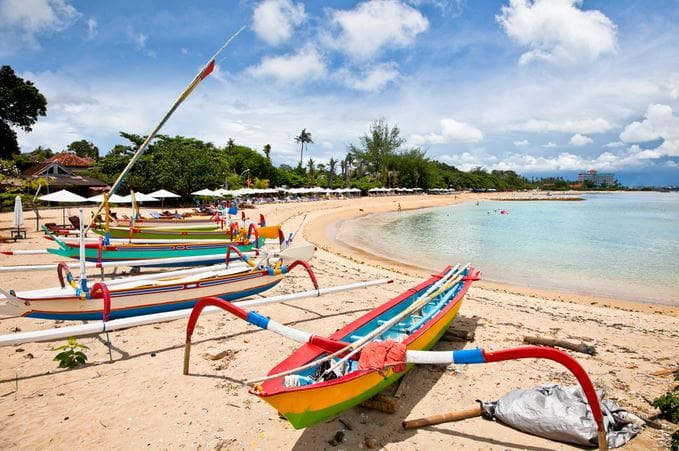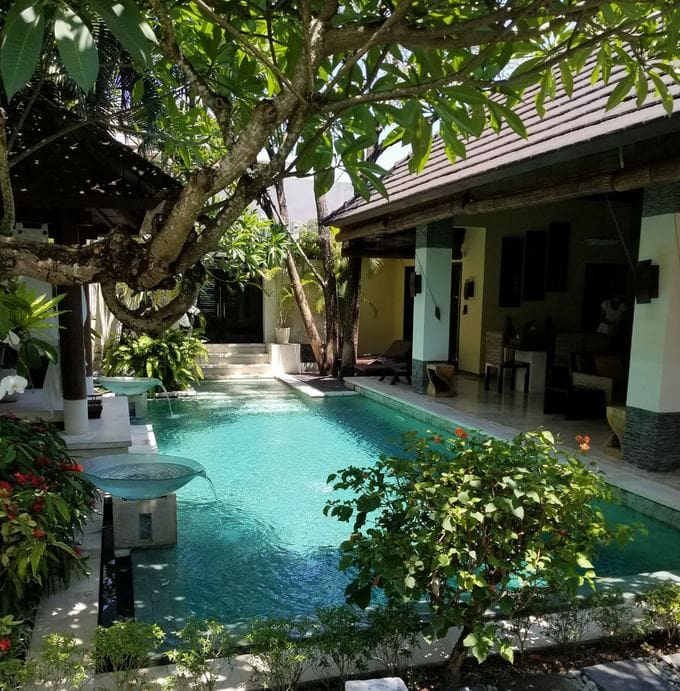South Bali Scooter Diaries: A Beginner’s Guide to Sanur

A guide to Sanur for plain folk who are about to visit the yoga hipster capital of the world.
If you’ve ever posted a sunset yoga pose on Instagram, this Bali travel guide is not for you. If your carry-on luggage includes a hula-hoop, this guide is also not for you.

If, however, you savor the idea of endless affordable sushi, luxury villa stays for the price of a Super 8, and hour-long massage sessions that cost the same as a Martini back home… then this is for you.
Welcome to Sanur, Bali
This Bali travel guide focuses on the southeastern corner of the island, Sanur. Compared with the southwestern corner, Kuta, it’s less inundated with surfboards and the 20-somethings that ride them. Sanur is not about all-night raves on the beach.
Think of Sanur as more of a stomping ground for Australians who are well past their party days. Australia is but a few hours away by plane so expect to see a lot of Aussies in Bali.
Introducing Sanur, the Anti-Kuta
Sanur is all about living a beautiful lifestyle for the duration of your stay. It’s about being able to afford the luxurious things in life that are normally reserved for celebrities and people who work really hard at high-paying jobs and who can afford anything they desire. Stay in full-service resorts, order room service, have a driver take you on day-long excursions, eat sushi every day, hire a fishing guide just for the heck of it, book a massage every afternoon… all without worrying about prices. For the time you’re in Bali, you get to see how the other half lives but minus the annoying paparazzi suffered by celebs or the stressful, high-powered job eating away at you even while you’re on vacation.
Why Sanur is Supreme
For those of you who never read Eat, Pray, Love or who never even saw the movie, Bali has become somewhat of a “thing” these past 12 years since the book came out. There’s a reason sunset yoga poses got their start in Bali and it’s Eat, Pray, Love by Elizabeth Gilbert.
This book characterized Bali as a mecca for yoga-inspired travel and in doing so created a decade-long tidal wave of yoga tourists… mostly women. The more refined of the bunch headed to the picturesque mountain village of Ubud, an artist colony specializing in yoga retreats for westerners. Although the book focused on Ubud, the crowds settled in Kuta.
Bali has always been something of a tourist spot but all this was new. Women hoping to achieve the levels of enlightenment and joy they read about in Elizabeth Gilbert’s book put Bali on the map all over again for a new generation. Then, seeing as 20-something men are apt to follow 20-something women (especially those in yoga pants), the surfers arrived shortly thereafter. And once that happened, let the party begin.
Ground Zero for the partying is Kuta, now famous for all-night raves on the beach, avocado toast, and cheap dormitory-style lodging. So you can see why Sanur is supreme if you’re not into the scrappy surfer party scene.
Sanur Basics: Where to Stay

There are basically two types of lodging for tourists in the Sanur area:
- Home-Stays. Economical, bare-bones lodging with breakfast included ($15/night to $30/night)
- Villas. Resort-style lodging with nicer rooms, on-site restaurant, pool, other amenities ($30/night to $70/night)
- International Hotel Brands. Chains like Hiltons that guarantee international standards of service, decor, amenities, etc. ($200/night and up)
The best deal is the middle category. You get incredible value at these places, which often have special services that are not only unheard of in the USA but also characteristic of 5-star hotels. For example, it’s not uncommon to get all this included in the price of your room:
- Afternoon tea served in your room – we’re talking strawberry crepes!
- Free rides anywhere in Sanur in the hotel van- like your own personal taxi
- 4-course breakfast
- Bottled water
- Rides to the airport (which is a 45- minute drive even in the best traffic conditions)
Sanur Basics: What and Where to Eat
You can ply the sidewalks with the other tourists and eat at the restaurants that cater to tourists and not really have a bad experience. Another option is to explore the many warungs that dot the side streets and outer neighborhoods of Sanur. Warung means “casual place to eat” and there are tons of them all over Bali. They operate like cafeterias: you queue up in front of a smorgasbord of tubs filled with delicious, if not labeled) food. Catch the eye of someone behind the counter to get things started:Catch their eye and they will grab a plate
They’ll spoon some rice onto the plate, allowing you to signal when to stop
They’ll go over to the bins and wait patiently while you decide what you want
Point, and they start ladling!
Signal when you think your plate is piled high enough
They’ll give you your plate along with some little cards
Find a spot at a communal table and enjoy.
When you’re done, take the cards to the cashier. Those cards are your bill!
Pay in cash.
Wonderful food and you can pile it on for about $3 a plate.
Sanur Basics: Getting Around

The best way to get around Sanur (and the city of Denpasar, for that matter), is on a scooter. Scooters rule the roads in Bali. Bicycling is tough because there’s no clear place for bicycles on the streets. Resorts in Sanur offer free bicycles but they’re mainly for putt-putting around Sanur.
Taxis are an option but if you stay in Bali for a long time you’ll soon become frustrated with all the traffic jams… especially after you start noticing how scooters are constantly zipping around you in stuck traffic.
Taxis are cheap and efficient for short jaunts down Jalan Danau Tamblingan, the main tourist drag. Pay about $1 to zip down to your favorite sushi place without sweating. Try to only take the Blue Bird taxis, though. They’re the only ones that are metered. Otherwise, you end up haggling every time and it gets very tedious.
A Final Word: What About WiFi?
Can you make it as a tourist without constantly plugging in? For those who falter with an answer, who aren’t totally sure they can muster the courage to unplug… the folks in Sanur, Bali have made this question moot.
Cafe owners and shopkeepers have ensured that Jalan Danau Tamblingan, is liberally sprinkled with WiFi hotspots. Even many of the tiny, 4-table eateries on side streets have WiFi. Local business owners have learned their lessons well in the past decade since Bali became a hipster pilgrimage site: if you’re not offering WiFi, you’re not offering much at all.
And, as Bali transitions to the land of the Digital Nomad, with remote workers settling in and calling it home, WiFi becomes even more essential for doing business. Cafes can be found everywhere and nobody cares if you stay for hours.
Even if you’re not a hipster or a digital nomad, it’s good to know that WiFi is ubiquitous in Sanur. Just don’t forget your on-the-go phone adapter. If you’re in Bali and your phone isn’t charged, you’re going to miss out on documenting what may be the best vacation you ever had.




